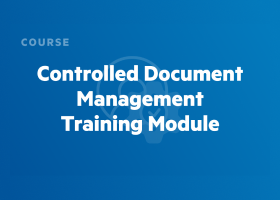Comprehensive Guide to Controlled Documents in Life Sciences
Let’s jump in and learn:
- Comprehensive Guide to Controlled Documents in Life Sciences
- Understanding the Types of Controlled Documents
- Importance of Effective Management of Controlled Documents
- Best Practices for Creating and Maintaining Controlled Documents
- Compliance and Regulatory Considerations
- Leveraging Technology for Enhanced Document Control
- Controlled Documents Provide a Multitude of Benefits in Life Sciences
Comprehensive Guide to Controlled Documents in Life Sciences
Controlled documents are formally managed records that are handled according to specific regulations and standards. These are designed to maintain their accuracy, reliability, and integrity throughout their lifecycle, from creation to archiving or destruction. The primary purpose of a controlled document is to provide clear, accessible, and current information that is essential for the consistent operation and quality control of organizational processes.
Controlled documents can include policies, procedures, work instructions, policies, manuals, records, forms, and any other type of document that is essential for the effective operation and compliance of a life sciences organization. Controlled documents are typically found in industries where strict regulatory compliance is required, such as healthcare, biotech, and pharmaceutical manufacturing.

Understanding the Types of Controlled Documents
Controlled documents can vary widely in form and function, depending on the specific needs and regulatory requirements of the organization. The following are several common types of controlled documents that warrant special treatment due to their critical role in organizations’ operations.
Change control documents
These documents record changes to processes, products, or systems, including the rationale for the change, impact assessments, and approval records. They ensure that changes are made systematically and with full traceability.
Clinical protocols and monitoring plans
In sectors like healthcare and pharmaceuticals, these documents outline the methodology for conducting clinical research and monitoring its progress.
Forms and templates
Forms and templates standardize the collection and recording of data. They are used to ensure that all necessary information is gathered uniformly, supporting accurate data management, analysis, and reporting.
Legal and contractual documents
Contracts, agreements, and other legal documents are controlled to ensure that they are up-to-date and accessible to authorized personnel. This category also includes policies related to compliance with laws and regulations.
Manuals
Manuals are detailed guides that provide specific instructions for carrying out particular tasks or operating equipment. They often include troubleshooting information, safety guidelines, and maintenance procedures to ensure proper operation and compliance.
Policies and procedures
These documents outline the guiding principles and the standard operating procedures (SOPs) for a life sciences organization. Policies provide the framework for decision-making, while procedures describe the step-by-step actions needed to carry out tasks consistently and effectively.
Protocol amendments
Any changes to an original protocol are documented as amendments and are controlled documents.
Quality records
Quality records are documents that provide evidence of compliance with quality management standards. They include audit reports, inspection records, test results, and training records. Quality records provide proof that procedures were followed and standards were met.
Regulatory submissions
Regulatory submission documents are critical for highly regulated life sciences organizations (e.g., pharmaceuticals or medical devices). These documents include applications, notifications, and reports submitted to regulatory agencies to obtain approval for products or report on safety and efficacy.
Safety data sheets (SDS)
Safety data sheets provide information on the properties of chemical products, including hazards, handling instructions, and emergency measures. For teams that handle hazardous materials, SDSs are crucial for compliance and safety.
Standard operating procedures (SOPs)
Standard operating procedures are detailed, written instructions to achieve uniformity in the performance of specific functions.
Technical and design documents
In engineering and manufacturing, technical specifications, drawings, and design documents are controlled to ensure that products’ specifications and standards are consistently and accurately followed.
Training materials
Training materials ensure that employees are educated on the latest procedures, safety protocols, and compliance requirements. Controlled document procedures ensure these materials are current and accurate.
Work instructions
Work instructions are more detailed than procedures, providing specific, task-level guidance for executing tasks. They ensure that tasks are performed consistently, correctly, and safely, often including diagrams or pictures for clarity.
Importance of Effective Management of Controlled Documents
Effective management of controlled documents is crucial for life sciences organizations, especially those in regulated industries. Proper document control systems ensure operational excellence, compliance, and quality assurance. Several reasons why document control is important include the following.
Data integrity and security
Effective document management systems protect sensitive information and maintain the integrity of data with version control and audit trails. This is crucial for maintaining the confidentiality of proprietary information and personal data.
Decision support
Controlled documents often contain valuable data and insights that can inform decision-making. By effectively managing these documents, organizations ensure that decision-makers have timely access to accurate and up-to-date information, enabling better strategic planning and risk management.
Knowledge sharing and collaboration
Controlled documents facilitate knowledge sharing by making vital information accessible to all relevant stakeholders. This promotes collaboration within and across teams and departments, leading to innovative solutions and continuous improvement in processes.
Legal and audit readiness
In the event of legal challenges or audits, well-maintained controlled documents can serve as evidence of compliance and due diligence. Effective document control ensures that information is readily accessible and accurately reflects the organization’s adherence to documented procedures and standards, which can facilitate a favorable audit outcome or legal defense.
Operational consistency and efficiency
Well-managed controlled documents provide clear, accessible instructions and guidelines for operational tasks. This consistency reduces errors, streamlines workflows, and enhances overall efficiency by ensuring that all team members follow the same procedures and processes.
Quality assurance
Controlled documents are vital for quality management systems. They contain the standardized procedures and guidelines that the required quality standards consistently meet across all products and services. Effective document management also supports quality improvement initiatives and helps maintain high standards.
Regulatory compliance
For many organizations, especially in sectors like healthcare, biotech, and pharmaceutical manufacturing, adhering to regulatory requirements is mandatory. Proper management of controlled documents ensures that policies, procedures, and records comply with industry standards and legal obligations, thereby avoiding legal penalties and fines.
Training and onboarding
For new employees, controlled documents such as policies, procedures, and work instructions are essential training tools that help them understand their roles and responsibilities quickly. Efficient document control ensures that training materials are current and relevant, speeding up the onboarding process and improving workforce competency.
Best Practices for Creating and Maintaining Controlled Documents
Establish a document control system
A robust document management system should be implemented to automate and streamline document control processes with version control, access control, audit trails, and electronic signatures. This system will facilitate easy retrieval and ensure that only the current versions of documents are accessible to authorized personnel.
Audit and monitor compliance
Document control processes should be monitored continually and audited on a regular basis to ensure that document control processes are being followed and to identify areas for improvement. Use audit findings to remediate issues and improve the document management process.
Conduct regular reviews and revisions
A schedule should be established for periodic review of controlled documents to ensure they remain accurate, relevant, and compliant with current regulations and standards. Document any changes made during revisions, including the rationale behind them.
Create standards for document identification
Every controlled document should have a unique identifier (e.g., a document number), title, author, creation date, and version number. This facilitates easy tracking, management, and retrieval of documents.
Develop and use standardized templates
Use standardized templates for controlled documents to ensure consistency across the organization. Templates should include predefined sections for document identification, purpose, scope, procedures, and any other relevant information.
Enforce access controls
Access to controlled documents should be restricted based on roles and responsibilities to ensure that employees can only access documents relevant to their job functions and that sensitive documents are adequately protected from unauthorized viewing or alteration.
Establish a review and approval workflows
Detailed workflows should be developed to review and approve documents. This should include all relevant stakeholders. Additionally, electronic signatures should be used where possible to track approvals clearly and securely.
Define document control procedures
Clear and comprehensive procedures should be in place for document creation, review, approval, distribution, revision, and archiving of controlled documents. These procedures should outline roles and responsibilities, including who is authorized to create, edit, approve, and access documents to ensure accountability.
Implement standardized templates
Using standardized templates for different types of controlled documents (e.g., SOPs, policies, and forms) ensures consistency across documents and makes them easier to read, understand, and maintain.
Maintain version control and document history
Strict version controls should be implemented to ensure that only the most current version of a document is in use. Archive outdated versions in a way that they are retrievable for audit purposes but clearly marked as superseded. This is important for compliance purposes and for understanding the rationale behind changes.
Plan for disasters
Document control systems should include functionality to support the recovery of controlled documents in the event of a disaster (e.g., system failure, cyberattack, or natural disaster).
Train employees
Provide training for all personnel on controlled documents and the document management system, document control procedures, their specific roles and responsibilities related to document control, and the consequences of non-compliance. Training should be updated and repeated as necessary, especially when new systems are implemented or procedures are changed.
Compliance and Regulatory Considerations
Life sciences organizations must have a thorough understanding of the regulatory requirements specific to their industry and operational jurisdiction. This includes HIPAA for healthcare, GxP for pharmaceuticals, ISO standards for quality management, and GDPR for data protection in the EU. Among the areas to consider with regard to controlled documents and adherence to compliance and regulatory requirements are:
- Access control and confidentiality
Access to controlled documents is a key part of most regulations. Access to controlled documents must be restricted to authorized personnel only, with mechanisms in place to protect confidential and sensitive information. This includes physical security measures for paper documents and cybersecurity measures for electronic documents. - Audit trails and record-keeping
Document control systems should be in place to provide comprehensive audit trails, recording every action taken on a document, including access, edits, approvals, and archiving. - Continuous compliance monitoring
Regulatory environments are dynamic, with frequent updates and changes to standards. Organizations must continuously monitor these changes and adjust their document management practices accordingly to maintain compliance. - Data integrity and security
Ensuring the integrity and security of controlled documents is vital to ensuring compliance with regulations. This involves safeguarding documents against unauthorized alterations, loss, or breaches. - Document creation and approval
Regulatory bodies often require that controlled documents undergo a formal creation, review, and approval process. This process should be well-documented, with clear evidence of who created, reviewed, and approved each document, along with date stamps to demonstrate compliance with procedural timelines. - Retention and disposal
Different regulations specify minimum retention periods for various types of documents. Organizations must adhere to these requirements, securely archiving documents for the required duration and disposing of them appropriately once they are no longer needed. - Sharing and collaboration
When controlled documents need to be shared, especially with external parties (e.g., partners, contractors, or regulatory agencies), organizations must ensure that these exchanges comply with confidentiality agreements and regulatory requirements regarding data sharing. - Training and awareness
Regulations often require that employees be trained on relevant policies and procedures and the proper handling of controlled documents. Organizations must keep records of training sessions, including attendees and training content, to demonstrate compliance. - Version control and document history
Maintaining strict version control is essential to ensure that only the most current, approved versions of documents are in use. Regulatory audits frequently examine document histories to verify that organizations are using correct versions and that historical data is accurately preserved for reference during an audit.
Leveraging Technology for Enhanced Document Control
Document management systems (DMS) provide a suite of tools to store, manage, and track controlled documents. They provide a centralized repository for controlled documents, enabling easy access, version control, and secure sharing. Features like automated workflows for document review and approval processes streamline operations and ensure compliance. Functionality to look for when assessing DMS options includes the following.
Artificial intelligence (AI) and machine learning (ML)
AI and ML can automate the classification, tagging, and indexing of controlled documents, which significantly reduces manual efforts and improves the accuracy of document retrieval. AI-powered analytics can also extract insights from unstructured data within documents, facilitating decision-making processes.
Blockchain technology
Blockchain offers an immutable ledger for document transactions, providing security and integrity for controlled documents. It ensures that once a document is recorded on a blockchain, it cannot be altered or tampered with, making it ideal for critical documents that require stringent controls, such as those used in clinical trials and pharmaceutical manufacturing.
Cloud-based platforms
Cloud-based document management solutions offer scalable storage, remote access, and collaboration tools, which facilitate all aspects of the life sciences industry, from research to clinical trials. These platforms ensure that documents can be accessed and edited securely from anywhere, fostering teamwork and enabling organizations to operate more flexibly.
Compliance and audit trail functionality
Advanced document control technologies include features that support compliance with the regulatory requirements for the life sciences industry, such as audit trails, which record every action taken on a document. This is crucial for demonstrating compliance during audits and investigations.
Collaboration tools
Modern collaboration platforms integrate document management capabilities, allowing team members to work together on documents in real time, track changes, and communicate within the same environment. This enhances productivity and ensures that all team members are aligned.
Data loss prevention (DLP) tools
DLP tools protect protected health information (PHI) from being leaked or accidentally shared. They monitor and control data transfer, ensuring that controlled documents and the information they contain are not sent outside the organization without proper authorization.
Electronic signature capabilities
Electronic signatures enable the digital signing of documents within the organizations and with patients, providing a secure and legally recognized way to obtain approvals without the need for physical paperwork. This technology speeds up the document approval process and enhances traceability.
Mobile accessibility
Mobile access to document management systems is essential. Mobile apps enable users to view, edit, and approve documents on the go, increasing responsiveness and operational flexibility.
Optical character recognition (OCR)
OCR technology enables different types of documents, such as scanned paper documents, PDFs, or images, to be converted into editable and searchable data. This facilitates the digitization of paper-based archives and improves the efficiency of document processing.
Controlled Documents Provide a Multitude of Benefits in Life Sciences
Implementing a controlled document system enables life sciences organizations to manage their sensitive information efficiently and comply with strict industry regulations. It also helps standardize operations, improve quality control, and ensure easy access to accurate and up-to-date information. Controlled documents play a pivotal role in the governance of organizational processes, ensuring that activities are carried out in a consistent, efficient, and compliant manner. Implementing and following robust document management practices and systems is also essential for safeguarding an organization’s operational integrity, competitive edge, and reputation.
Egnyte has experts ready to answer your questions. For more than a decade, Egnyte has helped more than 22,000+ customers with millions of users worldwide.
Additional Resources

How to Import your Historical Controlled Documents into Egnyte
In this article, you’ll learn how to import your existing SOPs, work instructions, and other ...

Controlled Document Management Training Module
This training module streamlines the rollout of effective documents, like Standard Operating Procedures, with assignment due ...

Egnyte Life Sciences
Simple to use, easy to deploy, and built to perform under GxP regulatory standards.